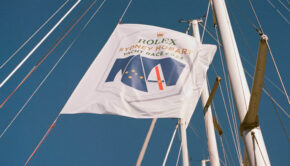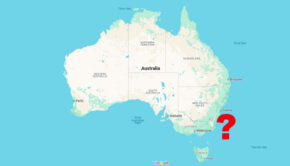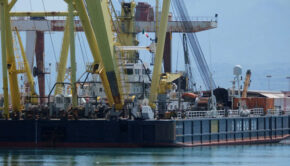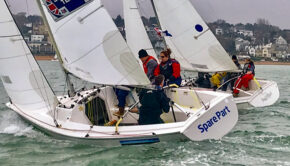Uncontrollable Urge: The Islands Race Accident
Published on September 4th, 2013
The 2013 Islands Race, held off the coast of Southern California, was marred on Friday, March 8 by a sailing accident aboard Uncontrollable Urge, a Columbia Carbon 32, that resulted in the death of a crew. Here is a report provided by four of the surviving crew: James Gilmore, Michael Skillicorn, Doug Pajak, and Ryan Georgianna…
At approximately 9:26pm on March 8, 2013 the rudder on the sailboat Uncontrollable Urge broke off during a storm off San Clemente Island in southern California. Two and one half-hours later, the boat was aground on the lee shore of San Clemente Island. Events during the two and a half-hour ordeal resulted in the loss of our friend and crew member, Craig Williams.
Uncontrollable Urge was a new boat and still being put through its paces. The Islands Race was being used as a qualifier for longer offshore races, Transpac 2013 in particular. Although the boat was performing well in our division, we were not racing particularly hard as our purpose was to assess the functionality of the various systems on the boat in offshore conditions.
Uncontrollable Urge was one of the farthest outside boats of the fleet while rounding San Clemente Island (appx 2nm) with mixed waves of height to 10 feet and winds of 25+ knots gusting. Immediately after loss of steerage the skipper called the USCG to inform them of our situation and to ask for assistance in arranging a commercial tow with our contracted towing service. The skipper, believing there was more time available due to SOG readings of 0 to 0.2kt, and that commercial towing would be readily available, initially declined assistance from fellow racers due to the dangerous conditions.
Throughout the incident, Uncontrollable Urge was in constant radio contact with the USCG. The crew began building and deploying different means of steerage (two emergency rudders, drogues, warps and motoring), but with none of these working and a tow not available for 20 hours, the USCG launched a rescue. A call for help to all boats went out, but by then the fleet had sailed past the island.
The boat grounded, and was rolled by a large breaking wave to starboard: two crew members thrown overboard were able to swim ashore; two other crew members went overboard but were trapped in their tethers; and two crew members remained on board. The tethered crew members either released themselves or were eventually cut free. The two crew members aboard rode the boat in and then swam ashore.
All six crew were wearing Type V inflatable lifejackets (some including thigh straps), and all properly inflated. While swimming ashore five of the six-lifejacket bladders pulled over the heads of the crew in the heavy surf (including those wearing thigh straps). One crew member found Craig with his lifejacket over his head, floating face-down and gave him CPR, but was unable to revive him. A helicopter from the USCG located the crew on the island and winched the remaining crew to safety before recovering Craig’s body.
We have worked with investigation teams to understand the causes of the accident that led to the death of our friend and crewmate, Craig Williams. The survivors of this accident believe there are immediate actions that can be taken by fellow sailors should they find themselves in a similar situation, however some of these may not be found within reports or are not easy to discern.
In specific, we believe that:
1) Always carry a proper emergency rudder offshore regardless of conditions or race rules. Your emergency rudder should be of equal or greater durability than your primary rudder. The design of the rudder system should be one that can be quickly placed into service even in the most severe conditions. Relying on towing from either commercial or from fellow boats is not dependable or could be unsafe to all parties.
2) Sailors need to modify their communications protocol with the USCG. In specific, they should consider having a current copy of the USCG Decision Matrix next to their VHF station. This helps clarify meanings and intents. As they walk through the matrix with the USCG, sailors needing assistance should ask the ETA of all assets responding. See USCG SAR in Appendix 1.
3) When upon a lee-shore and an accident occurs that causes loss of control of the boat, there is very little time available to make decisions. The first decision needs to be getting rescue assets in motion- regardless of whether crew or authorities believe they are in immediate danger. Boats that may not be capable of performing the rescue may still be able to provide other assistance such as radio communication and coordination. A boat that loses steerage on a lee-shore should be considered in immediate danger by both the crew and authorities- even if the boat still has the ability to anchor.
4) Sailors should be cautious regarding SOG readings while drifting.
5) It is our experience that the auto-inflating PFD’s worn by our crew were not adequate in these rough conditions. Sailors should be aware that the force of wave action can pull the bladder away from the harness and over your head, even if thigh straps are worn. If forced to abandon their vessel, sailors should consider taking off their auto-inflating PFD’s and put on an offshore Type 1 lifejacket. If possible, leave the vessel with some type of additional floatation.
6) Sailors need to understand the risks of putting fellow sailors in jeopardy when determining rescue options. Rescue attempts can easily go awry for both the accident victims and the best-intended would-be rescuers. Techniques need to be tested and be up to date with changes in technology so that both sailors and rescuers are not led to poor decisions based on speculation.
7) Not utilizing offsets in offshore island rounding marks is dangerous to the racing community and puts rescuers such as the USCG in danger. Offsets would likely have prevented the Low Speed Chase fatalities, may have helped the Aegean enter marks further from North Coronado Island, and would have added precious rescue hours to the Uncontrollable Urge incident. Had Uncontrollable Urge been further from shore physical assistance from another racing vessel could have been less dangerous. The racing community already deals with exclusion zones and the tracking technology is included in most offshore races, so this is easy to implement.
It is important to note that sailing bodies perform significant service to our racing community. However their activities require integration into the business industry of sailing and the coordination with governing bodies, so they may be influenced by certain legal considerations and courtesies. Our note to the sailing community is not bound by these considerations and has only one purpose, to convey the hard lessons that we learned. We are grateful every day to the USCG for the rescue service they perform.








 We’ll keep your information safe.
We’ll keep your information safe.